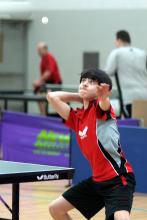Whether you want to make the US Olympic Team, win the senior games, or beat your Uncle Bob; it is always a great idea to scout out your competition. In this article, I’m going to describe two separate methods of scouting your table tennis opponent. The first is the long-term method. This is best accomplished by video analysis. The second is short term; this is a more common situation. You enter a tournament and are watching your opponent play the round robin group ten minutes before your match against him. You have never seen him before, and you need to quickly make a game plan.
How to Scout an Opponent, Long-Term
Serve
When studying an opponent, the first thing to watch is his serve. Watch the motion, watch the bounce, watch how the ball reacts off the table, and watch how the ball reacts off the opponent’s racket. Obviously when watching, you can’t “feel” the spin, but you can get “a feel” for the types of serves that he will probably serve against you. If possible, watch a video of him playing against you or against someone who has a similar style and level to yours.
Serve Return
Next, study how this opponent returns serve by asking yourself the following questions.
1. Does he attack long serves with both forehand and backhand? If so, with what stroke? If not, how does he return them?
2. Does he attack short serves with both forehand and backhand? If so, what location does he usually attack to? If not, does he return long or short?
3. Are there any particular serves that he misses repetitively?
How He Wins Points
This point is slightly more general. Does he win most of his points by attacking or by allowing his opponent to attack first? If he wins most of his points by attacking, find out his biggest weapons and try to stop them. If he wins most of his points from his opponent missing, then try to be very consistent, eliminate your own errors, and choose the right ball to hit strong.
Specific Strengths
Now let’s discuss in more detail about his strengths. First, check his stance. Is he in a forehand stance or backhand stance? Second, check his grip. Does he have a forehand grip (racket rotated to the thumb side of the palm) or a backhand grip (racket rotated to the index finger side of the palm)? Third, check his footwork. Does he move better to the forehand side or to the backhand side? When moving wide, does he move back or stay close to the table?
Specific Weaknesses
His weaknesses might be very evident. However, it is a good idea to analyze one or two full games and mark each time he misses with a particular stroke. For example:
Forehand loop against under spin I
Backhand loop against under spin IIIIIII
Forehand loop against topspin
Backhand loop against topspin I
Backhand push III
Forehand push IIIIII
Forehand block II
Backhand block I
Smash I
By looking at the statistics, you can clearly see that he missed many forehand pushes and many backhand loops against under spin. This will give you an indication that those might be two of his biggest weaknesses. This can get much more complex. For example, during 2 games, he might have pushed 50 balls with his forehand and missed six. He might have attempted three backhand pushes and missed all three. So this kind of charting needs to be used only as an outline.
Game Patterns
Most game patterns happen in the first three shots. Watch how your opponent uses his serve to set up a great loop, an easy smash, or a well-placed block. If he does have patterns that he wants to play, you need to be aware of them and have a game plan to stop his winning routine.
End Game
At the end of a tight match, most players will change their games slightly –
They might play more risky by playing extra power. They might play less risky by reverting to a push/block game. They might pullout a secret serve that they were saving for the entire match. They might tighten up and feel nervous to use their backhand or forehand. They might call an umpire or try to cause controversy. Regardless of what happens, you need to be aware of their tendencies. Be ready to keep your opponent off-guard and be ready to adjust to his change.
How to Scout an Opponent, Short-Term
When playing in a tournament, you sometimes will have a very short notice on who your next opponent will be. In this case, try to watch him play a match in the previous round or in the round robin group. With only a few minutes to watch, I suggest that you focus your attention on two things:
1. His serve
2. How he wins points
Envision yourself playing him. Watch the serve, then immediately question yourself as to what the best return would be. See how his opponent returned the serve and confirm your answer by watching how the ball reacts off his racket. It is very important to watch the subtle differences that he makes in varying the spin with the same motion.
See how he wins points. Does he win most of his points by forceful attacking? Or does he win most of his points by allowing his opponent to miss? Once you have these two things solved, you will be thinking clearly when you formulate a pre-game strategy against this opponent.
Also, be willing to ask a friend or other players in the round robin group. His last opponent might be able to give you insight that you hadn’t foreseen.




